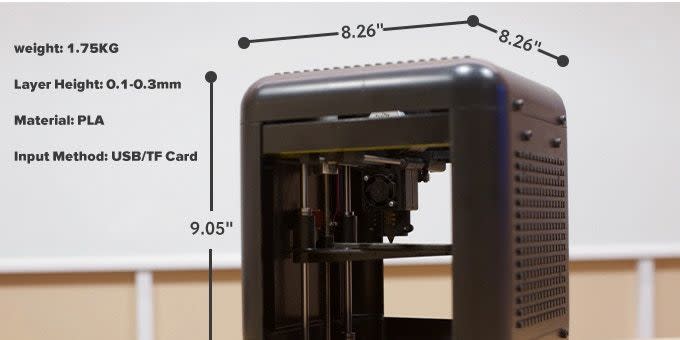A Tiny Home 3D Printer Can Be Yours for $79

A tiny 3D printer that began at $59 has earned almost 2,000 preorders on Kickstarter.
With that price tag, some enthusiasts are skeptical.
The printer uses renewable PLA plastic, primarily to make small toys and figures.
A project promising a working 3D printer for just $60 (plus $30 shipping) has raised almost $200,000 on Kickstarter. Since the 3DFORT fundraiser went live last month, curious people on Reddit and social media have wondered: How can this thing be legitimate? But even with the skepticism, it’s clear there’s a huge market for a 3D printer that’s truly affordable to a much larger swath of people.
Across all discussions of this printer, commenters tend to say interested folks are better off buying a low-end traditional 3D printer. “Quite a bit more at $300, but well worth the cost,” one Redditor says of the Ender 3, a product at the very bottom end of Creality’s line of printers.
For some groups, 3DFORT is the only affordable option there’s ever been, with a limited use case that scales with the price. Naturally, the printer is really small—the entire roughly cubic unibody is about 9 inches on each side, and the maximum printable size is about 9 centimeters per side.
3DFORT can also only use low-temperature polygalactic acid (PLA) plastic, which is a downside for some kinds of users. But PLA is made from renewable materials and can be decomposed safely in the right facility.
“The raw material for PLA manufacturing is any fermentable sugar,” manufacturer Cargill Dow (CD) explains in a paper. More from CD:
“Carbon dioxide is fixed in crops to make starches. Agriprocessing like corn wet-milling convert the starches to simple sugars. CD buys the sugar and uses it to ferment lactic acid. Using chemical processing techniques, lactic acid is converted efficiently to lactide, a ring-form dimer of lactic acid. PLA is made through ring-opening melt polymerization. The overall process is sufficiently efficient in terms of yield and energy that the products are economically viable.”
So this small printer uses a renewable kind of plastic to shape very small items, and the Kickstarter page repeatedly references “toy bricks”—a sly genericization of the LEGO brand.
The printer is covered in bumps that users can attach these bricks to. Critics have called this a gimmick, but we suspect it's signaling outright who the makers want this low-cost printer to serve: people with children who want to 3D print small toys and figures.
The printer could make small, sharply detailed shapes in the same vein as the touristy Mold-o-Rama machines—with or without the characteristic burning smell, and definitely without the polyethylene plastic. Nearly 2,000 people have purchased some level of 3DFORT, which kicked off at just $59 plus shipping and is now pre-selling for $79 plus shipping in its final week. We’ll find out soon if the sensibly scaled-down machine does what it promises.
You Might Also Like

